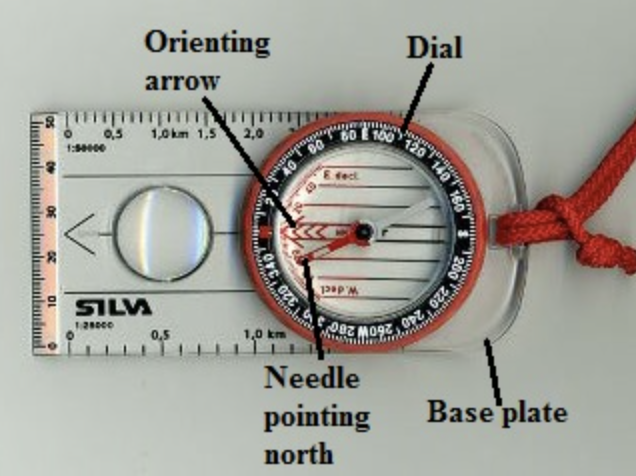Features of a Good Compass
A compass and map are mandatory gear for outdoor adventures. Note: a GPS receiver is optional because you should never rely solely on a battery-powered device for survival. Knowing how to read a map and use a compass, you’ll always know where you are and the best route to where you’re going.
A compass works by detecting and responding to the Earth’s natural magnetic field/core with two poles, north and south. The magnetic poles are slightly off from the Earth’s axis of rotation (used as the basis of the geographic poles), but the magnetic and geographic poles are close enough, and when adjustments (or declination) are made for the polar differences, a compass becomes a powerful tool.

Look for these features:
Declination adjustment: magnetic declination is the difference between magnetic north and true north. Check the NOAA website for the most accurate setting for your location. Reset in new locations.
Sighting mirror: for off-trail travel or precise navigation, it allows you to look at the object you’re taking a bearing from and your compass at the same time.
Clinometer: useful for assessing avalanche hazards, a clinometer measures the angle of elevation.
Global needle: essential for world travelers or trips south of the Equator as it compensates for magnetic-field variances in the different hemispheres.

While all compasses point in their designated direction, they may also have other helpful features:
Magnetized Needle: points to the magnetic pole.
Rotating Bezel: a ring marked with degrees from 0° to 360° used for taking bearings in the field.
Baseplate: has navigational markings and a ruler. The ‘direction of travel’ arrow is located at the front.
Arrows and Orienteering Lines: are used for basic navigational tasks. The red arrow Always points north, and the white arrow always points south. Orienteering lines are a series of parallel lines on the floor of the compass used to align the compass to a map.
Extra features like a magnifying lens (for reading maps) or luminescent indicators (for using your compass in low light) can be handy in certain situations.
Tips for compass use and storage:
Learn how to use your compass properly. Go online, find a class, or learn from a pro.
Avoid ferrous metals, electrical fields, and magnets when storing your compass, as they’ll affect its accuracy.
Store your compass away from magnets or electric fields to prevent demagnetization.
Clean your compass regularly with fresh water and mild soap. Storage temperature: -30° C - +60° C / -22° F
Choose a good compass, learn how to use it, and stay safe in the wilderness!
